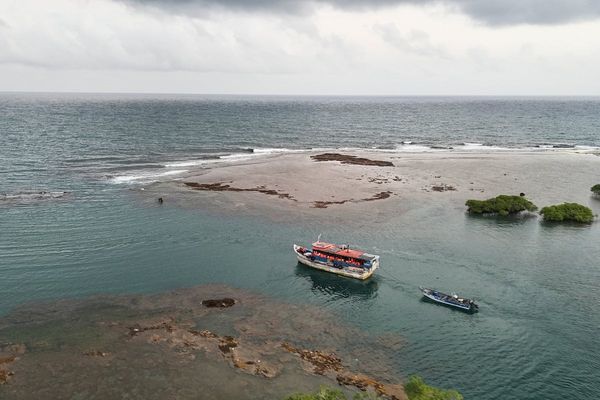
The kelp forests that hug the Pacific coastline are an underwater jungle. They're a thicket of colossal algae intermixed with a pageant of life that includes snails, urchins, sea lions, sea otters, and a host of seabirds.
"The current Pacific kelp forests are the base of very rich shallow marine ecosystems," says Cindy Looy, a paleobotanist at the University of California at Berkeley.
A study published in PNAS presents new evidence that the first kelps were much older than we once suspected, dating back 32 million years — well before the arrival of many of their present-day animal inhabitants.
This means that kelp was likely available as a food source for ancient marine mammals. And that the foundation of the ecosystem was already in place when kelp later evolved and grew dramatically in height, providing an even greater range of habitats to the ancestors of the animals we associate with them today.
When Looy gazes out at the Pacific Ocean from Point Lobos State Natural Reserve in Monterey, California, she knows the kelp forest with all its attendant species pulsates just below the surface.
"Just to think," she says, "that we now added a little tiny piece of the puzzle of when [the kelps] started and how the ecosystem diversified — that makes me very proud."
A lucky find at the beach
Jim Goedert is a retired railroad signal inspector. He lives outside of Tacoma, Washington where, for years, he's regularly driven up to the north side of the Olympic Peninsula to walk along the rocky shoreline.
"Gray whales and seals come in, and occasionally orcas," he says. "There are kelp beds offshore." At low tide, when large swaths of the beach become exposed, Goedert goes in search of fossils including hard, round masses called concretions.
"We would crack these open," he says. "And sometimes there's a crab or some other fossil in these rocks. But I would find these little squiggly veins or roots. I couldn't really tell what they were."
One day, during a break on one of his beach walks, Goedert came across a mound that had washed ashore of kelp holdfasts — the root-like structures that fasten the towering algae to the seafloor.
"And I thought, 'That's what that thing is — kelp,'" he says. "It was just an aha moment."
Goedert packed up some of his best specimens, drove to the post office, and shipped them to Stockholm to a professional.
"He just kept sending me holdfasts," recounts Steffen Kiel, a senior curator at the Swedish Museum of Natural History and a collaborator and friend of Goedert's. Some of the fossils weren't that impressive but "sometimes they were, like, wow," he says. Still, "I just left it alone for a few years because as usual I had other things to do."

Asking a fossil how old it is
Kelp fossils are exceedingly rare. "We all know things fossilize — big vertebrates, dinosaurs, things with bones and hard parts," says Ceridwen Fraser, a marine scientist at the University of Otago in New Zealand. "But kelp is a very squidgy organism." Plus, says Kiel, "they quickly rot away because they are eaten up by microbes and various animals. Kelps are essential[ly] edible, nutritious soft tissue." It all adds up to very little kelp making it into the fossil record.
Years ago, researchers used a single specimen from California to estimate that complex kelps emerged at least 13 or 14 million years ago. (Complex kelps differ from simple kelps in a few ways, including that they have distinct stems and leaves.) More recently, genetics helped push that date back to at least 30 million years. But there was no fossil evidence to back that number up, which made Kiel wonder whether the samples he'd received from Goedert might offer some insight. So eventually, he took a closer look, cutting into them and polishing their surfaces.
On one, a splotch of root-like tendrils appears to be draped across the rock. "That's the holdfast," says Kiel, pointing. "I have various specimens where they were sitting on a bivalve shell, on a clam shell or especially often on barnacles."
He took one of those fossilized shells that the kelp had glued itself to and performed a chemical analysis involving strontium isotopes to determine its age.
"We then knew exactly, pretty much exactly, that these fossils were 32 million years old," says Kiel. "No doubt about it."
This result confirms the earlier genetics work, but the fossils are stronger proof that complex kelp date back to the early Oligocene, a time of dramatic global cooling.
"The whole world's oceans got a hell [of a] lot colder right at that time," says Kiel. "Kelp like it cold. So that was a perfect fit."
Why the earlier arrival of kelp matters
The fact that complex kelp have been around for so long means a couple things. First, it helps resolve a puzzle about an ancient vegetarian marine mammal related to today's manatees called the desmostylian.
"People were wondering what they were actually feeding on 30 million years ago," says Kiel. "What kind of green fresh food would there be? And now, our kelp fossils show, yeah, hippo-sized desmostylians most likely were happily feeding on this kelp."
It's logical, says Looy: "Kelps can grow incredibly fast and those desmostylians are relatively big and they have to eat a lot to stay alive." Now that the researchers know that both kelp and desmostylians were alive at the same time, "we can more or less rewrite the history of the kelp ecosystems," she says.
Here's the second insight: "This whole rich ecosystem that we know now must have gradually evolved," Looy says.
That is, for millions of years, the kelp ecosystem was quite simple with the kelps themselves being somewhat short, maybe a few feet tall. Then, around 14 million years ago, much taller kelps evolved, forming the underwater forests we know today. And that's when a thriving hub of biodiversity slowly began to materialize in this new wealth of vertical habitat — "all these animals that characterize modern kelp ecosystems — full with all sorts of life," says Kiel, from invertebrates to larger grazers.
Fraser, the marine scientist, says the findings are exciting.
"I have been approached before by people who thought they had kelp fossils and I wasn't convinced," says Fraser, who wasn't involved in the study. "But what we're looking at are very clearly kelp."
Fraser studies kelp evolution and how its DNA mutates, something she anchors in time using the fossil record.
"And the annoying thing about kelp is there's hardly anything known from the fossil record," says Fraser. "So this will be a tool that I can use now to better understand how kelps are evolving and what's happened through time."
Kiel says he's delighted that once again, fossils have taught him a familiar, yet fundamental lesson about our world.
To him, they're an archive of life throughout Earth's history — an archive that sometimes washes ashore where all you have to do is look for it.







